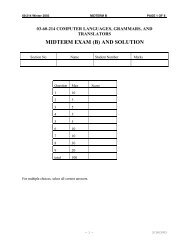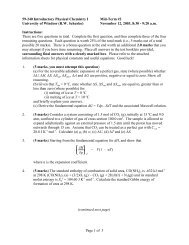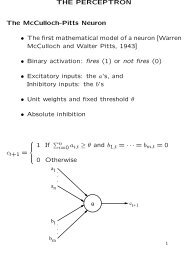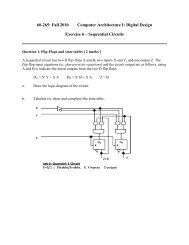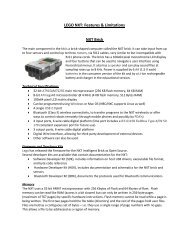Adjectives: A Uniform Semantic Approach - University of Windsor
Adjectives: A Uniform Semantic Approach - University of Windsor
Adjectives: A Uniform Semantic Approach - University of Windsor
You also want an ePaper? Increase the reach of your titles
YUMPU automatically turns print PDFs into web optimized ePapers that Google loves.
336 N. Abdullah and R.A. Frost<br />
Guitarist = {j: guitarist,…} : guitarist<br />
Musician = {j: musician, …}: musician<br />
Veteran = {j: musician}: veteran<br />
Where j = ||John||<br />
From this representation, it is clear that the statement John is a veteran guitarist<br />
cannot be affirmed. This is because j is not in the intersection <strong>of</strong> Veteran and<br />
Guitarist.<br />
Maria is a former teacher<br />
Maria is a programmer<br />
---------------------------<br />
Therefore, Maria is a former programmer (Invalid)<br />
Set representation:<br />
Human = {m: human,…} : human<br />
Teacher= {m: teacher,…} : teacher<br />
Former= {m: teacher,…} :former<br />
Programmer={m: programmer,…} : programmer<br />
Inference examples:<br />
(6)<br />
├ m ∈ (Former ∩ Programmer) Expected answer: false<br />
├ m ∈ (Former ∩ Human) Expected answer: false<br />
3.3 Multiple-<strong>Adjectives</strong>-One-Head-Noun Combinations<br />
In the previous section, we presented an intersective treatment <strong>of</strong> adjective-noun<br />
combinations. In this section, we extend this treatment to include adjectival phrases<br />
with multiple adjectives and a head noun.<br />
3.3.1 An Analysis<br />
Providing an intersective account for expressions with multiple adjectives and a head<br />
noun is a more challenging task than single-adjective-noun combinations. This is<br />
because an adjective in a combination can have different scopes. To illustrate,<br />
consider examples (7).<br />
a) Oceania is a deep blue ocean<br />
b) Companies favour intelligent, aggressive people<br />
c) Jane is an attractive blond woman<br />
In (7-a), deep may have wide scope, i.e. modifies blue ocean, or narrow-scope, i.e.<br />
modifies blue. (7-b) is not ambiguous, because <strong>of</strong> the comma. (7-c) is ambiguous, due<br />
to wide and narrow scope readings.<br />
An at-face-value, set-theoretic representation for the examples in (7) is not<br />
possible, with the exception <strong>of</strong> example (7-b). This is due to the associative law <strong>of</strong> set<br />
theory, stated below:<br />
∀ Sets A, B, and C A∩ (B ∩C) = (A ∩B) ∩C<br />
Thus, for instance, mapping example (7) to set intersections would fail to capture the<br />
different possible readings. In particular, consider the wide-scope reading <strong>of</strong><br />
attractive in (7-c). This reading can be expressed as follows:<br />
(7)







